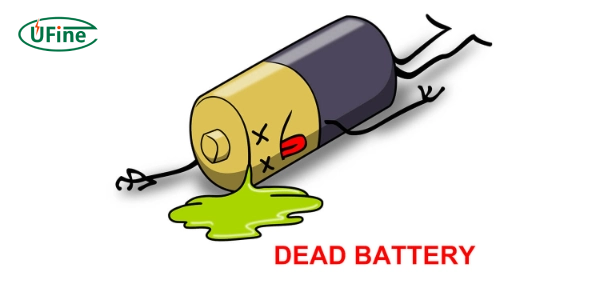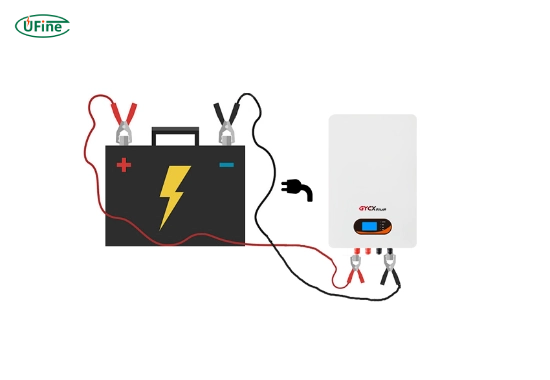How to revive a dead battery? If your battery stops charging or becomes unresponsive, don’t panic. In this guide, we’ll look at what causes these issues, share tips on how to revive a dead battery, and address common problems with lithium-ion batteries. Plus, we’ll explain how long a lithium-ion battery can last without charging and why regular maintenance is key to keeping your batteries in good shape.
Part 1. Causes of dead batteries
- Overcharging: Leaving devices plugged in for extended periods, especially overnight, can lead to overcharging, damaging the battery’s capacity and overall health.
- High Temperatures: Exposing batteries to high temperatures, such as leaving them in a hot car or near a heat source, accelerates chemical reactions within the battery, causing it to degrade faster.
- Deep Discharge: Allowing a battery to discharge before recharging can lead to irreversible damage, particularly in lithium-ion batteries, resulting in decreased capacity and lifespan.
- Physical Damage: Dropping or mishandling devices can cause physical damage to the battery, leading to internal short circuits or ruptures that render the battery unusable.
- Age and Wear: Like all components, batteries degrade over time with repeated charging cycles. As batteries age, their capacity diminishes, leading to shorter usage and eventual failure.
- Manufacturing Defects: Occasionally, batteries may have inherent defects from the manufacturing process, such as material impurities or faulty construction, which can cause premature failure.
- Software Glitches: In some cases, software issues within the device can cause abnormal battery drain or charging problems, leading to premature battery failure if not addressed.
- Low Voltage Conditions: Operating devices under low voltage conditions, consistently discharging the battery to deficient levels, can cause irreversible damage and lead to dead batteries over time.
- Improper Storage: Storing batteries in inappropriate conditions, such as extreme temperatures or high humidity, can accelerate degradation and contribute to premature failure.
- Non-Optimal Charging Practices: Using improper chargers or charging devices in non-recommended ways can lead to overcharging, undercharging, or inconsistent charging patterns, contributing to battery failure.
Part 2. How to revive a dead battery?
Reviving a dead battery can be a helpful skill, saving you time and money. Here are a few methods that can help:
Recharge the Battery
The simplest way to revive a dead battery is to recharge it. Connect the battery to a compatible charger and allow it to charge fully. This process might take some time, so be patient. Once the battery reaches an adequate charge level, it should start functioning again.
Jump-Start the Battery
Jump-starting is a standard method for reviving car batteries. Connect the dead battery to a functioning vehicle’s battery using jumper cables. Let the working vehicle run for a few minutes, boosting the dead battery. Attempt to start the car with the dead battery, and if successful, let it run to recharge.
Use a Battery Reconditioner
Battery reconditioners are devices designed to restore the performance of dead or weak batteries. They apply controlled charging and discharging cycles to the battery, helping break down sulfation (a common cause of battery failure) and improve overall battery health.
Warm Up the Battery
Warming the battery to room temperature can improve its performance if it is cold. However, avoid excessive heat sources, which can further damage the battery.
Part 3. How do you fix a lithium-ion battery that won’t charge?
If you encounter a lithium-ion battery that won’t charge, consider the following steps:
Check the Charging Cable and Port
First, inspect the charging cable for any signs of damage, such as frayed wires or bent connectors. Similarly, examine the charging port on your device for debris or obstructions. Cleaning the port with compressed air or a soft brush can help establish a proper connection and restore charging functionality.
Perform a Hard Reset
Sometimes, a hard reset can resolve charging issues with lithium-ion batteries. This involves turning off the device, removing the battery (if possible), and holding the power button for 15-20 seconds. Reinsert the battery (if applicable) and attempt to charge the device again.
Reset the Battery Management System (BMS)
Some devices have a built-in Battery Management System (BMS) regulating charging and discharging. Resetting the BMS can sometimes resolve charging issues. To do this, fully discharge the battery, then recharge it to total capacity without interruption.
Freeze the Battery
This method involves placing the battery in a sealed bag and placing it in the freezer for several hours. Freezing the battery can temporarily restore its ability to hold a charge by stabilizing the chemicals inside. However, this method is also suitable for types of lithium-ion batteries, and there is a risk of damaging the battery if not done correctly.
Apply a Controlled Overcharge
Applying a controlled overcharge can sometimes revive a lithium-ion battery that won’t charge. This involves connecting the battery to a charger with a slightly higher voltage than usual for a short period. However, users should approach this method cautiously, as overcharging can damage the battery incorrectly.
Replace the Battery
If all else fails, the lithium-ion battery itself might be the problem. In such cases, contacting the device manufacturer or a professional technician is advisable to obtain a replacement battery. Ensure you purchase a genuine battery compatible with your device, as counterfeit or incompatible batteries can pose safety risks.
Lithium Battery Not Charging and How to Solve it?
Part 4. How long can a lithium-ion battery last without charging?
Self-Discharge Rate
Lithium-ion batteries naturally lose charge over time, even when not in use. The self-discharge rate differs between battery models but is generally low. On average, a lithium-ion battery can retain approximately 80% of its charge after one month of inactivity.
Battery Capacity
The initial capacity of the battery also plays a role. Higher-capacity batteries tend to retain their charge for longer periods than lower-capacity ones. However, it’s important to note that the self-discharge rate remains a factor, regardless of the battery’s capacity.
Part 5. Importance of battery maintenance
Proper battery maintenance is crucial for maximizing battery life and performance. Here’s why it matters:
Prolonged Battery Lifespan
To significantly extend the lifespan of a battery, practice regular maintenance, such as avoiding over-draining and ensuring timely recharging. By adopting good battery habits, you can reduce the frequency of dead batteries and the need for replacements.
Optimal Performance
Well-maintained batteries consistently deliver optimal performance. Whether it’s a smartphone, laptop, or any other device, an adequately taken care of battery will provide longer usage times and reliable charging capabilities.
Cost Savings
By maintaining your batteries effectively, you can save on replacement costs. Dead batteries often necessitate purchasing new ones, which can be expensive, especially for devices with non-removable batteries. Taking care of your batteries properly can help you avoid unnecessary expenses.
Environmental Impact
Proper battery maintenance also has positive environmental implications. By extending the lifespan of batteries, we reduce the number of batteries that end up in landfills. This contributes to a greener and more sustainable approach to battery usage.
Part 6. Final thoughts
In conclusion, by understanding the causes of dead batteries, we can take proactive steps to prevent their failure. Through effective maintenance practices, such as avoiding over-draining, handling batteries carefully, and storing them correctly, we can prolong their lifespan and ensure reliable power for our devices. Additionally, timely troubleshooting and utilizing appropriate revival techniques can help us revive dead batteries and restore their functionality.
Related Tags:
More Articles

Paper Battery vs. Flexible Battery: What’s the Difference and Which Is Better?
Paper vs. flexible batteries: learn the key differences, benefits, and which power source fits best for wearables, sensors, and smart tech.
What to Know Before Buying a Tiny LiPo Battery for Your Project
Tiny LiPo batteries are powerful and compact. Learn how to choose the right one for your project with specs, safety, and charging tips.
Bloated LiPo Battery: Will It Explode?
Will a bloated LiPo battery explode? Discover the causes, risks, safety steps, and expert tips to avoid disaster and protect your gear. Must-read safety guide!
12V 100Ah Lithium Ion Battery Price: Full Guide
Learn about 12V 100Ah lithium-ion battery price, from cost ranges to best brands, hidden fees, and how to get the best deal. A must-read for smart buyers!
Resistance and Conductivity: What It Means for Your Lithium Batteries
Resistance and conductivity impact lithium battery performance, lifespan, and safety—learn how they work and why they matter.





